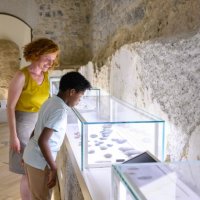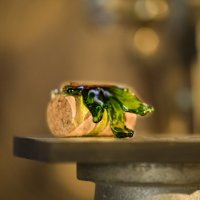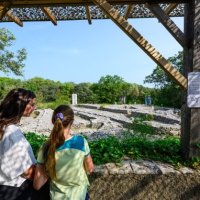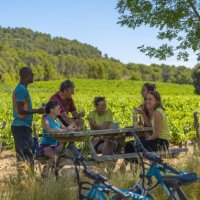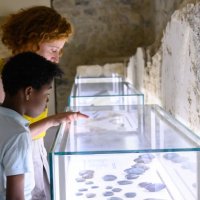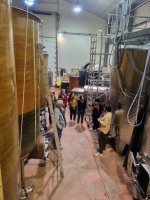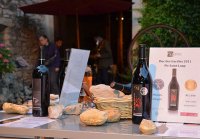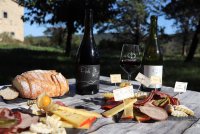Between Grés de Montpellier and Pic Saint-Loup
Discover the charming villages north of Montpellier, with their Romanesque churches, medieval fortifications... and moving reminders of the Languedoc's earliest inhabitants.
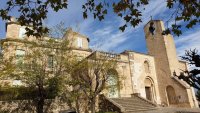
Between fragrant garrigues, pine forests and vineyards, discover the most beautiful facets of the Pic Saint-Loup and taste wines that live up to the landscapes in which they were born.
Test your eyes on the "vines in full bloom" section. Leaning against the foothills of the Cévennes, an amphitheatre of vineyards surrounds Montpellier and overlooks the Mediterranean: AOC Grés de Montpellier, AOC Pic Saint Loup, AOC Languedoc, and IGP Saint-Guilhem-Le-Désert Val de Monferrand. Let's explore the villages.
From the village of Assas to Sainte-Croix-de-Quintillargues
Between vineyards and herds, you'll discover the château, more of a "folly" like those that dot the Montpellier countryside. Privately owned, the château can be visited on request. Don't miss the church of St Martial, inherited from the Languedoc Romanesque period (late 11th, early 12th century).
Inside, an organ dating back to 1906. To taste: wines from the Grés de Montpellier appellation. The expression Grés (pronounced: gré) comes from the Occitan caillou and refers to the poor, stony soils at the top of the hills, which, thanks to the Mediterranean influence, enable the vines to grow deep roots and produce lower yields.
A selection of the best plots is used to produce the elegant red wines that are so characteristic of the appellation.
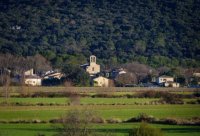
From Sainte-Croix-de-Quintillargues to Saint-Bauzille-de-Montmel
The village of Sainte-Croix-de-Quintillargues, on the ecosite trail, showcases the skills of charcoal burners, who have long since disappeared. It tells the story of generations of woodland men and women who came here from Italy after the First World War, living in small dry-stone huts known as charbonnières. Day and night, they watched the skilful millstones of holm oak being fired to deliver charcoal to the town. This Romanesque church is unusual in that it was raised during the Hundred Years' Wars.

From Saint-Bauzille-de-Montmel to Vacquières
Built in an area rich in prehistoric, proto-historic and Gallo-Roman sites. Listed as a Natura 2000 site, the Puech offers superb panoramic views as far as the Cévennes and is a renowned rock-climbing area. The wines are classified under the Languedoc-Grés de Montpellier appellation.
Take the "babara" road, following the signs for "Sur la route des verriers". A pretty little road surrounded by vines, right and left, surrounded by garrigue... Quite simply, the countryside!
From Vacquières to Sauteyrargues
Here we are in Vacquières. Here you'll see an old wind pump, built over a well dug in 1899 to carry water to a reservoir in the centre of the village. A small wine-growing village, it is also home to two glass-blowing craftsmen. On the road is the small hamlet of Vabre.
Sauteyrargues
"The vine in full bloom The vineyard alternates between landscapes enclosed by dense evergreen Mediterranean vegetation and those opening onto a vineyard sublimated by the majestic reliefs of the Pic Saint-Loup and the Hortus. Near the hamlet of Lascours, see Notre Dame d'Aleyrac (see the Vignes en paysages trail).
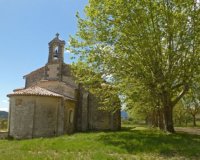
A little hidden, a little in the limelight... Sauteyrargues and its four hamlets (Vabre, Laudou, Lascours, Les Rives) offer small roads and forest paths ideal for walking or cycling.
From Sauteyrargues, return to Assas via the Saint-Mathieu-de-Tréviers road. On the main road, admire the curving vineyards of Mas Bruguière and Lancyre, against a backdrop of the Pic Saint-Loup and the Hortus. This is definitely vineyard country ....

Type : Road
Start: Assas
Length: 46 km
Time: 1h30
Difference in altitude: +150 /-150 m

55 resultsSort
To find out more

